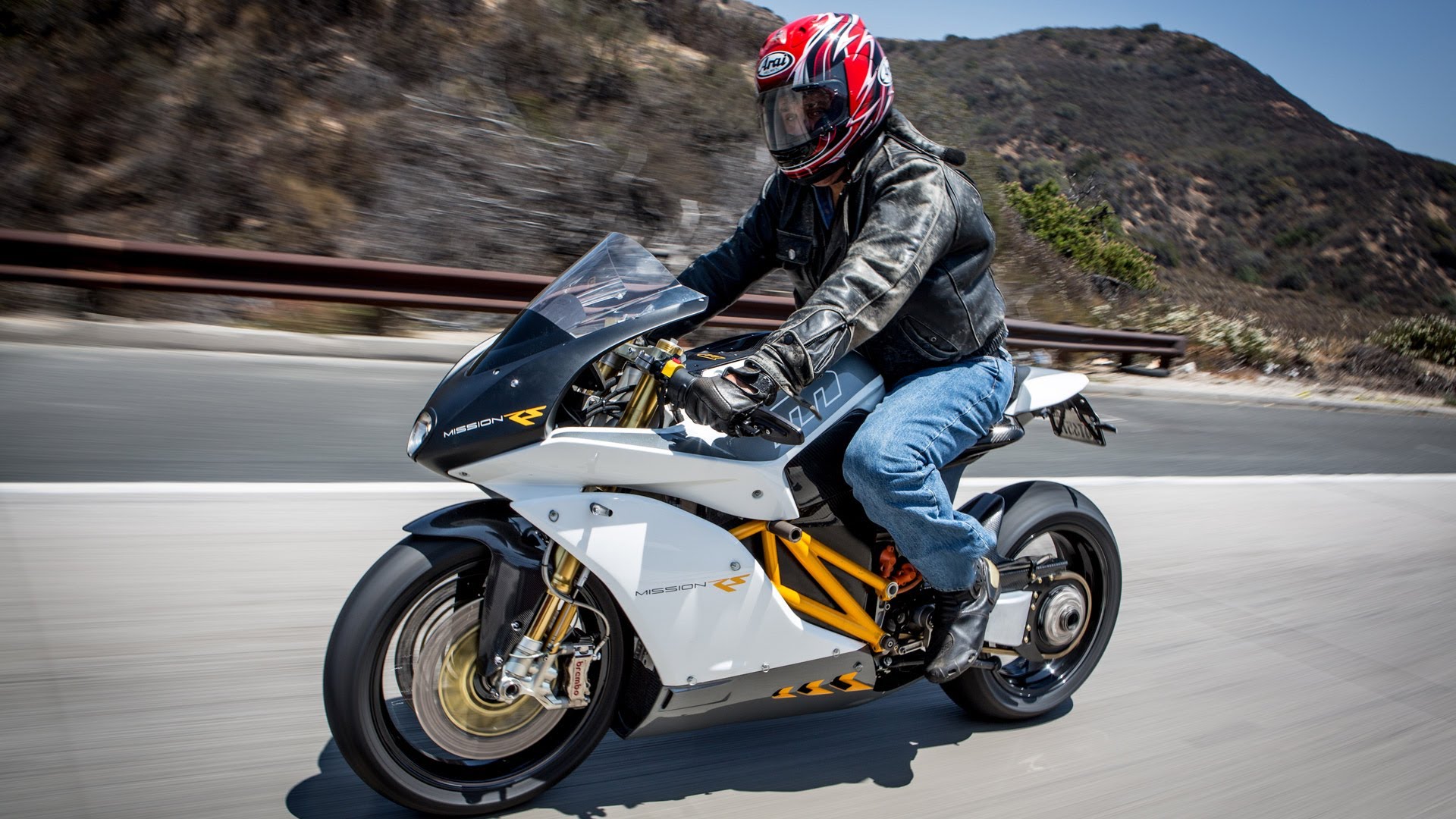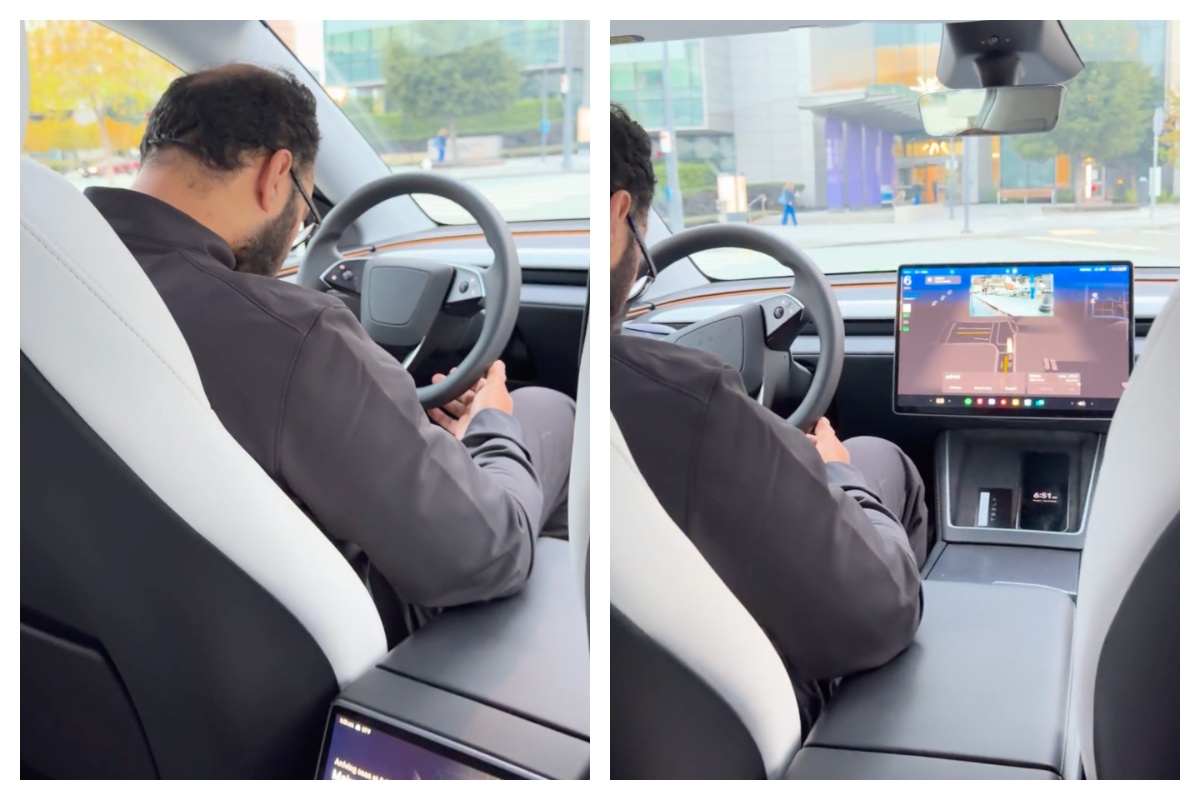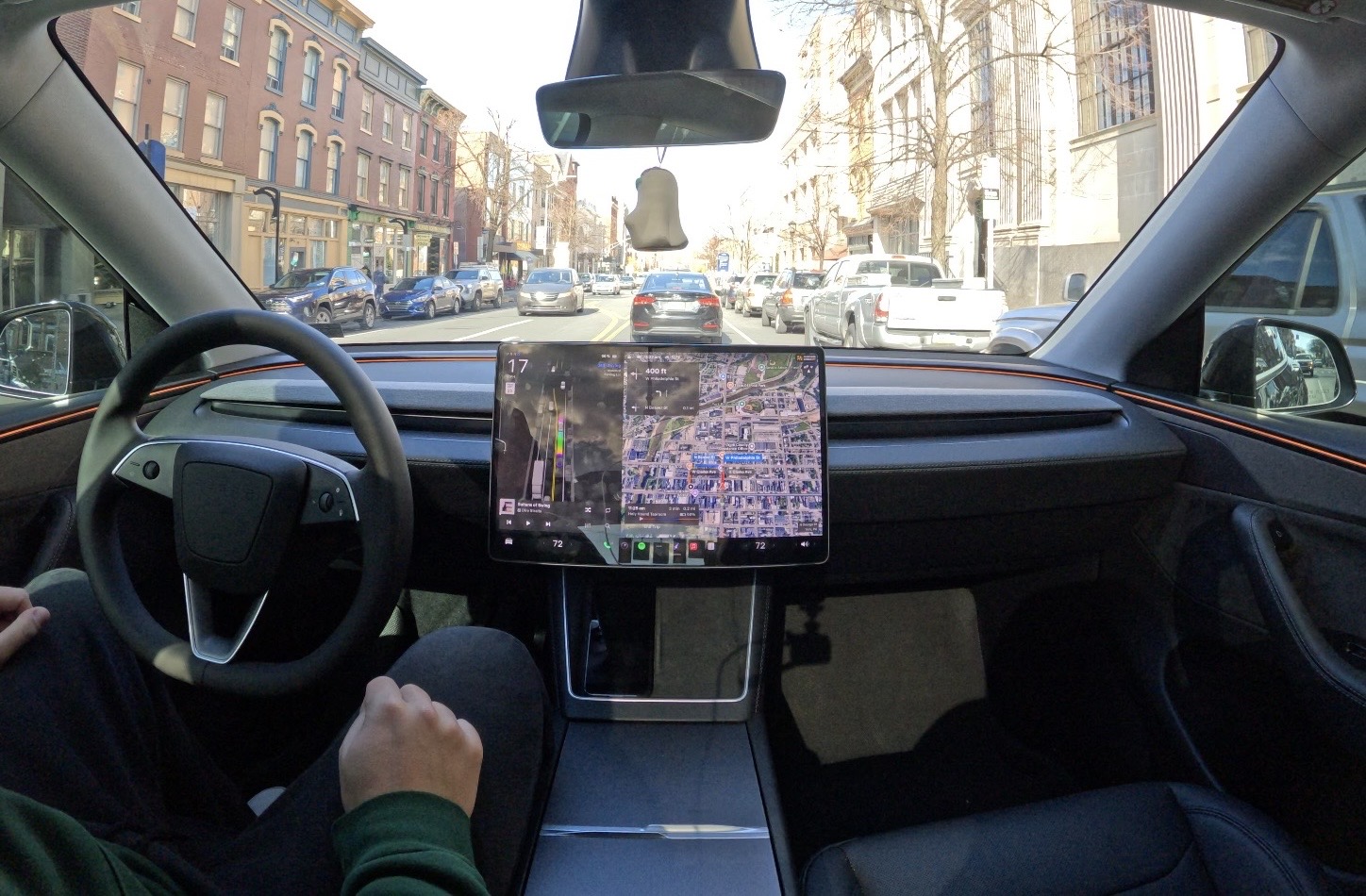Video
The Tesla of Electric Superbikes – Jay Leno Test Rides the Mission RS [Video]
I’ll admit it — I hardly know anything about motorcycles. Never been my thing*. Nevertheless, I know that the Mission RS electric superbike is an awesome motorcycle — by many accounts, the best motorcycle on the market. It’s the Tesla of motorcycles…

News
Tesla Full Self-Driving v14.2 – Full Review, the Good and the Bad

Tesla rolled out Full Self-Driving version 14.2 yesterday to members of the Early Access Program (EAP). Expectations were high, and Tesla surely delivered.
With the rollout of Tesla FSD v14.2, there were major benchmarks for improvement from the v14.1 suite, which spanned across seven improvements. Our final experience with v14.1 was with v14.1.7, and to be honest, things were good, but it felt like there were a handful of regressions from previous iterations.
While there were improvements in brake stabbing and hesitation, we did experience a few small interventions related to navigation and just overall performance. It was nothing major; there were no critical takeovers that required any major publicity, as they were more or less subjective things that I was not particularly comfortable with. Other drivers might have been more relaxed.
With v14.2 hitting our cars yesterday, there were a handful of things we truly noticed in terms of improvement, most notably the lack of brake stabbing and hesitation, a major complaint with v14.1.x.
However, in a 62-minute drive that was fully recorded, there were a lot of positives, and only one true complaint, which was something we haven’t had issues with in the past.
The Good
Lack of Brake Stabbing and Hesitation
Perhaps the most notable and publicized issue with v14.1.x was the presence of brake stabbing and hesitation. Arriving at intersections was particularly nerve-racking on the previous version simply because of this. At four-way stops, the car would not be assertive enough to take its turn, especially when other vehicles at the same intersection would inch forward or start to move.
This was a major problem.
However, there were no instances of this yesterday on our lengthy drive. It was much more assertive when arriving at these types of scenarios, but was also more patient when FSD knew it was not the car’s turn to proceed.
Can report on v14.2 today there were ZERO instances of break stabbing or hesitation at intersections today
It was a significant improvement from v14.1.x
— TESLARATI (@Teslarati) November 21, 2025
This improvement was the most noticeable throughout the drive, along with fixes in overall smoothness.
Speed Profiles Seem to Be More Reasonable
There were a handful of FSD v14 users who felt as if the loss of a Max Speed setting was a negative. However, these complaints will, in our opinion, begin to subside, especially as things have seemed to be refined quite nicely with v14.2.
Freeway driving is where this is especially noticeable. If it’s traveling too slow, just switch to a faster profile. If it’s too fast, switch to a slower profile. However, the speeds seem to be much more defined with each Speed Profile, which is something that I really find to be a huge advantage. Previously, you could tell the difference in speeds, but not in driving styles. At times, Standard felt a lot like Hurry. Now, you can clearly tell the difference between the two.
It seems as if Tesla made a goal that drivers should be able to tell which Speed Profile is active if it was not shown on the screen. With v14.1.x, this was not necessarily something that could be done. With v14.2, if someone tested me on which Speed Profile was being used, I’m fairly certain I could pick each one.
Better Overall Operation
I felt, at times, especially with v14.1.7, there were some jerky movements. Nothing that was super alarming, but there were times when things just felt a little more finicky than others.
v14.2 feels much smoother overall, with really great decision-making, lane changes that feel second nature, and a great speed of travel. It was a very comfortable ride.
The Bad
Parking
It feels as if there was a slight regression in parking quality, as both times v14.2 pulled into parking spots, I would have felt compelled to adjust manually if I were staying at my destinations. For the sake of testing, at my first destination, I arrived, allowed the car to park, and then left. At the tail-end of testing, I walked inside the store that FSD v14.2 drove me to, so I had to adjust the parking manually.
This was pretty disappointing. Apart from parking at Superchargers, which is always flawless, parking performance is something that needs some attention. The release notes for v14.2. state that parking spot selection and parking quality will improve with future versions.
Any issues with parking on your end? 14.1.7 didn’t have this trouble with parking pic.twitter.com/JPLRO2obUj
— TESLARATI (@Teslarati) November 21, 2025
However, this was truly my only complaint about v14.2.
You can check out our full 62-minute ride-along below:
News
Tesla ride-hailing Safety Monitor dozes off during Bay Area ride
We won’t try to blame the camera person for the incident, because it clearly is not their fault. But it seems somewhat interesting that they did not try to wake the driver up and potentially contact Tesla immediately to alert them of the situation.

A Tesla Robotaxi Safety Monitor appeared to doze off during a ride in the California Bay Area, almost ironically proving the need for autonomous vehicles.
The instance was captured on camera and posted to Reddit in the r/sanfrancisco subreddit by u/ohmichael. They wrote that they have used Tesla’s ride-hailing service in the Bay Area in the past and had pleasant experiences.
However, this one was slightly different. They wrote:
“I took a Tesla Robotaxi in SF just over a week ago. I have used the service a few times before and it has always been great. I actually felt safer than in a regular rideshare.
This time was different. The safety driver literally fell asleep at least three times during the ride. Each time the car’s pay attention safety alert went off and the beeping is what woke him back up.
I reported it through the app to the Robotaxi support team and told them I had videos, but I never got a response.
I held off on posting anything because I wanted to give Tesla a chance to respond privately. It has been more than a week now and this feels like a serious issue for other riders too.
Has anyone else seen this happen?”
My Tesla Robotaxi “safety” driver fell asleep
byu/ohmichael insanfrancisco
The driver eventually woke up after prompts from the vehicle, but it is pretty alarming to see someone like this while they’re ultimately responsible for what happens with the ride.
We won’t try to blame the camera person for the incident, because it clearly is not their fault. But it seems somewhat interesting that they did not try to wake the driver up and potentially contact Tesla immediately to alert them of the situation.
They should have probably left the vehicle immediately.
Tesla’s ride-hailing service in the Bay Area differs from the one that is currently active in Austin, Texas, due to local regulations. In Austin, there is no Safety Monitor in the driver’s seat unless the route requires the highway.
Tesla plans to remove the Safety Monitors in Austin by the end of the year.
News
Tesla Full Self-Driving (Supervised) v14.1.7 real-world drive and review
On an hour-long drive, we tested v14.1.7 and tested its new capabilities, which are mostly overall performance and smoothness fixes rather than integrations of new features that are unknown to routine FSD users.

Tesla started rolling out its Full Self-Driving (Supervised) v14.1.7 suite last night to owners, and there are several improvements to note within the new update that are at least the start of fixes to highly-mentioned issues.
On an hour-long drive, we tested v14.1.7 and tested its new capabilities, which are mostly overall performance and smoothness fixes rather than integrations of new features that are unknown to routine FSD users. However, there are a handful of shortcomings that are still present within the suite, which are not something that will be fixed within the span of a single update.
For what it is, Full Self-Driving does an excellent job of navigating — once you get it on its correct path. Our issues tend to be confined to navigation, routing, and the decision-making process that has to do with the way the car wants to get you to your destination. There were five things that happened on our first drive with v14.1.7 that are worth mentioning. The full drive will be available at the bottom of this article.
Navigation and Routing Still Seems to Be a Major Challenge
In past content, we’ve discussed the issues with routing and navigation, and how a Tesla chooses its path. Most noticeably, these issues occur in the same areas; for me, it’s my local Supercharger. My 2026 Model Y with AI4 continues to pick less-than-optimal routes out of the Supercharger, and in this instance, it actually chose to turn down a road, pull over, and give me the wheel, essentially asking, “Hey, can you get me on the right track here?”
This is still my biggest bone to pick with FSD, even more so than some of the bonehead moves it’s made in tougher scenarios (mostly parking lots with very limited visibility due to shrubs being planted in the worst possible locations). It’s rare that it happens, but this particular Supercharger has been a true thorn in the side of my Tesla.
This is not an issue that is confined to v14.1.7, or even v14 in general. Unfortunately, it is an issue that has persisted throughout my ownership experience, as well as during Demo Drives.
Still dealing with this Navigation/Routing issue. FSD still hasn’t figured out how to exit this Supercharger.
FSD chose to pull over and let me work it out of its predicament: pic.twitter.com/ZOIsA7eW2C
— TESLARATI (@Teslarati) November 13, 2025
Stuttering and Hesitation at Intersections was Non-Existent
There was some confusion regarding my language in a recent article where I stated Tesla is confronting the issues that have been reported regarding the “stabbing” with braking.
“Tesla began the v14.1.4 launch last night, which included minor improvements and addressed brake-stabbing issues many owners have reported. In my personal experience, the stabbing has been awful on v14.1.3, and is a major concern.
However, many things have improved, and only a couple of minor issues have been recurring. Many of the issues v13 addressed are no longer an issue, so Tesla has made significant progress.”
It has undoubtedly improved, but it is not resolved.
With that being said, I did not feel a single example of hesitation, stabbing, or stuttering at a single intersection or instance when it has been present in the past. CEO Elon Musk said it would be fixed with v14.2, so it seems like Tesla is well on its way to resolving it.
Proper Handling of Crosswalks
It’s crazy how many people still do not stop for pedestrians at clearly-marked crosswalks. I had two instances of it happen during the drive, with FSD stopping for those pedestrians both times.
Human drivers did not stop either time:
Two instances of FSD stopping for pedestrians at crosswalks while human drivers proceed: pic.twitter.com/b4W7GXsXwH
— TESLARATI (@Teslarati) November 13, 2025
Handled Merging onto a Highway with an Inconsiderate Driver Well
Routinely, drivers will get over into the left lane, if they are able, to allow merging traffic to safely enter the freeway. It does not always happen this way, and it’s not required by law.
Not exclusive to v14.1.7, as many past iterations would have done this as well, but it was nice to watch the vehicle slow down to let that traffic pass. It then entered the freeway safely, and the entire maneuver was well done.
Not exclusive to v14.1.7, but just a great job of allowing highway traffic to pass before merging: pic.twitter.com/Hl9Hr0N5Jc
— TESLARATI (@Teslarati) November 13, 2025
Took an Appropriate Move with Oncoming Foot Traffic and Debris in a Tight Alleyway
This was probably the most on-edge I was during the drive because: 1) FSD chose to take an unnecessary alleyway, and 2) there was a box and oncoming pedestrians.
The car was aware of everything that was going on. In order to avoid the box, it would have had to turn toward the pedestrians, and in order to avoid the pedestrians, it would have had to turn into the box.
It chose to wait patiently, and after the pedestrians were past the car, FSD chose to proceed.
A patient FSD debates pedestrians and debris.
It chooses to not turn toward the humans or the box, instead waiting for a clear path to proceed. EXCELLENT and my favorite part of the drive pic.twitter.com/JNVxuxkhmn
— TESLARATI (@Teslarati) November 13, 2025
Closing Thoughts
Overall, we’re very impressed with v14.1.7, and we think this is Tesla’s best iteration of the FSD suite yet, as it should be since it’s the newest version available. Tesla’s attention to detail regarding the brake stabbing is really well done, and it seems evident that a complete fix is on its way.
Other than the navigation issue at the very beginning, which was not an intervention, at least in my opinion, this was a really successful drive.









